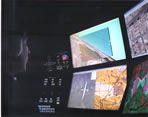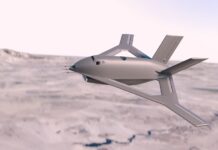 Several companies introduced new and advanced controls and payload systems at AUVSI 07. Among these were General Atomics, introducing their Next Generation Ground Control Station just prior to the event, Raytheon demonstrating their Multi Vehicle Control System (MVCS), a derivative of the UCS Ground Control System and IAI, introducing the latest version of the ground control console, known as iUCS.
Several companies introduced new and advanced controls and payload systems at AUVSI 07. Among these were General Atomics, introducing their Next Generation Ground Control Station just prior to the event, Raytheon demonstrating their Multi Vehicle Control System (MVCS), a derivative of the UCS Ground Control System and IAI, introducing the latest version of the ground control console, known as iUCS.
AST, presenting the lightweight Cell Spotter system to covertly monitor cellular communications traffic over a limited area. Enerdyne introduced a new hardware add-on which can be easily installed on any UAV, enabling users to send high capacity digital feed over existing analog datalinks. Controp, AeroMech and CloudCap unveiled new versions of stabilized payloads weighing under two pounds each, designed specifically for emerging mini-UAVs while Rockwell Collins unveiled the new TacVue Mini-SAR designed for small UAVs, developed in cooperation Sandia Labs.
 Israel Aerospace industries unveiled at AUVSI 07 its latest concept for the modular ground control system called iUCS. The new system will support all of Malat’s UAV fleet. The first UAV to be supported by the new system is the IAI/Malat Heron, and IAI’s latest entry into the MALE market – the Eitan (Heron TP).
Israel Aerospace industries unveiled at AUVSI 07 its latest concept for the modular ground control system called iUCS. The new system will support all of Malat’s UAV fleet. The first UAV to be supported by the new system is the IAI/Malat Heron, and IAI’s latest entry into the MALE market – the Eitan (Heron TP).
The new system fully supports STANAG 4586 ergonomically designed with a stacked mount supporting multiple displays and control table with a small footprint. The stacked design considerably saves space enabling multiple operators to comfortably work in a small shelter. The same display mount can converted into a ‘side by side’ configuration where space is available.
Procerus Technologies introduced an airborne and ground segment ensemble featuring the Kestrel autopilot, associated with the ‘virtual cockpit’ ground control software and ‘OnPoint’ targeting system. Kestrel is a 16.7 gram autopilot, designed for autonomous flight. Controlled by the ‘Virtual Cockpit’, Kestrel automatically follows a ‘click and fly’ commands performed by the operator. The Kestrel includes the autonomous GPS navigation system, an inertial measurement unit, and payload communications and support. The OnPoint targeting application offers precision target tracking initiated by a click of a mouse, localization and video stabilization. In addition to the Virtual Cockpit controls, it also enables ‘Click and Fly’ vision based flight control, by dragging the mouse over a visible target or flight route to initiate a new task.
‘click and fly’ commands performed by the operator. The Kestrel includes the autonomous GPS navigation system, an inertial measurement unit, and payload communications and support. The OnPoint targeting application offers precision target tracking initiated by a click of a mouse, localization and video stabilization. In addition to the Virtual Cockpit controls, it also enables ‘Click and Fly’ vision based flight control, by dragging the mouse over a visible target or flight route to initiate a new task.
Several companies introduced advanced image provessing designed to improve the products or overcome the limitations of EO payloads currently used by UAVs. For example, Toyon developed novel video tracking algorithms that can effectively track multiple targets in video collected by low-cost small UAVs using unstable imaging systems. The company also developed the wireless communications algorithms and supporting hardware for these applications. Another system was presented by Pyramid Vision, which launched their Video Quest product which can be integrated into the TeraMax 3D system showing the payload image in still photo or image, inlaid in the proper perspective ‘footprint’ on a 3d map or ortophoto to improve situational awareness, thus eliminating the ‘soda straw’ views of traditional payloads.
With Video Quest, the real-time video can be enhanced with with online geodatabase, automatically tagging and storing new streams with metadata and retrieving stored media for further analysis upon request. A search can be performed based on location, time, movement or other historical features. Video retrieval is performed much rapidly, compared to standard video recording systems. Future versions of VideoQuest will also feature ‘quality search’ reducing the time spent in downloading unusable videos, such as blurred videos or feeds with heavy cloud coverage. Other enhancements anticipated with future version include the integration of laser rangefinder to reduce geolocation error. Currently, the geolocation accuracy depends on the payload and sensors, average geolocation error provided by the system is within 10 meters. TerraMax and VideoQuest are already fielded with the US Army’s PTSD aerostat borne sensor system and with the ScanEagle UAV system. It will also be used with the Army’s Sky Warrior UAV systems.
 Kutta Consulting unveiled its unified ground control station (UGCS) interface, developed for the US Army small UAV systems. This interface was supporting Rockwell Collins’ Mini SAR. This intercafe packs a sophisticated control into a small hand held module such as a PDA or tablet PC. The fully functional UGCS is a lightweight STANAG 4586 compliant controller offering advanced features such as 3D or 2D flight planning, full VGA real-time video display with post-flight reviews, autonomous ‘point’ and ‘flow’ modes of operation, 2D or 3D footprint with terrain shadowing, grid search modes, automatic routing and intelligent health monitoring. For the Army project Kutta teamed with Boeing Phantom Works, Advanced Ceramics Research (ACR), and Neural Robotics Incorporated. Other uses for this hand controller include homeland Security, and first responder applications.
Kutta Consulting unveiled its unified ground control station (UGCS) interface, developed for the US Army small UAV systems. This interface was supporting Rockwell Collins’ Mini SAR. This intercafe packs a sophisticated control into a small hand held module such as a PDA or tablet PC. The fully functional UGCS is a lightweight STANAG 4586 compliant controller offering advanced features such as 3D or 2D flight planning, full VGA real-time video display with post-flight reviews, autonomous ‘point’ and ‘flow’ modes of operation, 2D or 3D footprint with terrain shadowing, grid search modes, automatic routing and intelligent health monitoring. For the Army project Kutta teamed with Boeing Phantom Works, Advanced Ceramics Research (ACR), and Neural Robotics Incorporated. Other uses for this hand controller include homeland Security, and first responder applications.
Topics covered in AUVSI 2007 review:
- Unmanned Systems – Flight and Ground Demonstration 2007
- UAV systems, including Combat UAVs
- Mini, Micro and Expendable UAV Systems
- The future USMC Tier II program
- High Altitude Long Endurance (HALE) Platforms
- Unmanned Transport Vehicles
- Mission Control Systems & Applications
- Advanced payloads for unmanned Systems
- UGVs and Controls Systems















